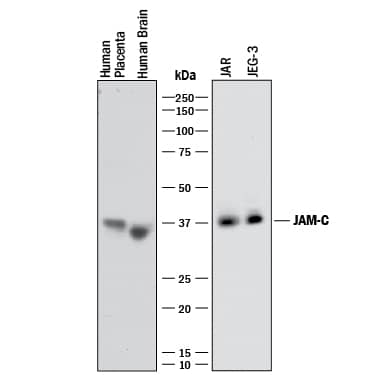Human JAM-C Antibody
R&D Systems, part of Bio-Techne | Catalog # MAB1189

Key Product Details
Species Reactivity
Validated:
Cited:
Applications
Validated:
Cited:
Label
Antibody Source
Product Specifications
Immunogen
Val32-Asn241 (Ala149Pro)
Accession # Q9BX67
Specificity
Clonality
Host
Isotype
Endotoxin Level
Scientific Data Images for Human JAM-C Antibody
Detection of Human JAM‑C by Western Blot.
Western blot shows lysates of human placenta tissue, human brain tissue, JAR human choriocarcinoma cell line, and JEG-3 human epithelial choriocarcinoma cell line. PVDF membrane was probed with 2 µg/mL of Mouse Anti-Human JAM-C Monoclonal Antibody (Catalog # MAB1189) followed by HRP-conjugated Anti-Mouse IgG Secondary Antibody (Catalog # HAF018). A specific band was detected for JAM-C at approximately 36-38 kDa (as indicated). This experiment was conducted under reducing conditions and using Immunoblot Buffer Group 1.Cell Adhesion Mediated by JAM‑C and Neutralization by Human JAM‑C Antibody.
Recombinant Human JAM-B/VE-JAM Fc Chimera, immobilized onto a microplate previously coated with Goat Anti-Human IgG Fc (Catalog # G-102-C), supports the adhesion of the J45.01 human acute lymphoblastic leukemia T lymphocyte cell line in a dose-dependent manner (orange line), as measured by endogenous cellular lysosomal acid phosphatase activity. Adhesion elicited by Recombinant Human JAM-B/VE-JAM Fc Chimera (0.2 µg/mL) is neutralized (green line) by increasing concentrations of Mouse Anti-Human JAM-C Monoclonal Antibody (Catalog # MAB1189). The ND50 is typically 0.01-0.05 µg/mL.Applications for Human JAM-C Antibody
Western Blot
Sample: Human placenta tissue, human brain tissue, JAR human choriocarcinoma cell line, and JEG‑3 human epithelial choriocarcinoma cell line
Neutralization
Formulation, Preparation, and Storage
Purification
Reconstitution
Formulation
Shipping
Stability & Storage
- 12 months from date of receipt, -20 to -70 °C as supplied.
- 1 month, 2 to 8 °C under sterile conditions after reconstitution.
- 6 months, -20 to -70 °C under sterile conditions after reconstitution.
Background: JAM-C
The family of juctional adhesion molecules (JAM), comprising at least three members, are type I transmembrane receptors belonging to the immunoglobulin (Ig) superfamily (1, 2). These proteins are localized in the tight junctions between endothelial cells or epithelial cells. Some family members are also found on blood leukocytes and platelets. Human JAM-C cDNA predicts a 310 amino acid (aa) residue precursor protein with a putative 31 aa signal peptide, a 210 aa extracellular region containing two Ig domains, a 23 aa transmembrane domain and a 46 aa cytoplasmic domain containing a PDZ-binding motif and a PKC phosphorylation site (3, 4). Human JAM-C shares 86% aa sequence identity with its mouse homologue. It also shares approximately 36% and 32% aa sequence homology with human JAM-B and JAM-A, respectively (3‑5). Human JAM-C shows widespread tissue expression and the highest levels are found in the placenta, brain, kidney and heart. JAM-C is expressed on endothelial cells of high endothelial venules in human tonsil. It is also expressed on platelets, T-cells and NK cells (3‑5). Unlike other JAM family members, JAM-C forms only weak homotypic interactions. JAM-C binds to JAM-B to facilitate the interactions between JAM-B and the integrin alpha4beta1 (6). This heterotypic interaction between leukocyte JAM-C and endothelial JAM-B may play a role in regulating leukocyte transmigration (5). On platelets, JAM-C is a counter-receptor for the leukocyte integrin Mac-1(CD11b/CD18) (7). JAM-C has also been identified as a strong candidate gene for hypoplastic left heart syndrome (8).
The nomenclature used for the JAM family proteins is confusing. VE-JAM has been referred to in the literature variously as JAM-B or JAM-C. Until further clarification, R&D Systems has adopted the nomenclature where both mouse and human VE-JAM are referred to as JAM-B. Under this system, JAM-C refers to the protein encoded by the gene localized to human chromosome 11.
References
- Chavakis, T. et al. (2003) Thromb. Haemost. 89:13.
- Aurand-Lions, M. et al. (2001) Blood 98:3699.
- Arrate, M.P. et al. (2001) J. Biol. Chem. 276:45826.
- Liang, T. et al. (2002) J. Immunol. 168:1618.
- Johnson-Leger, C. et al. (2002) Blood 100:25793.
- Cunningham, A. et al. (2002) J Biol. Chem. 277:27589.
- Santoso, S. et al. (2002) J. Exp. Med. 196:679.
- Phillips, H.M. et al. (2002) Genomics 79:475.
Long Name
Alternate Names
Gene Symbol
UniProt
Additional JAM-C Products
Product Documents for Human JAM-C Antibody
Product Specific Notices for Human JAM-C Antibody
For research use only

